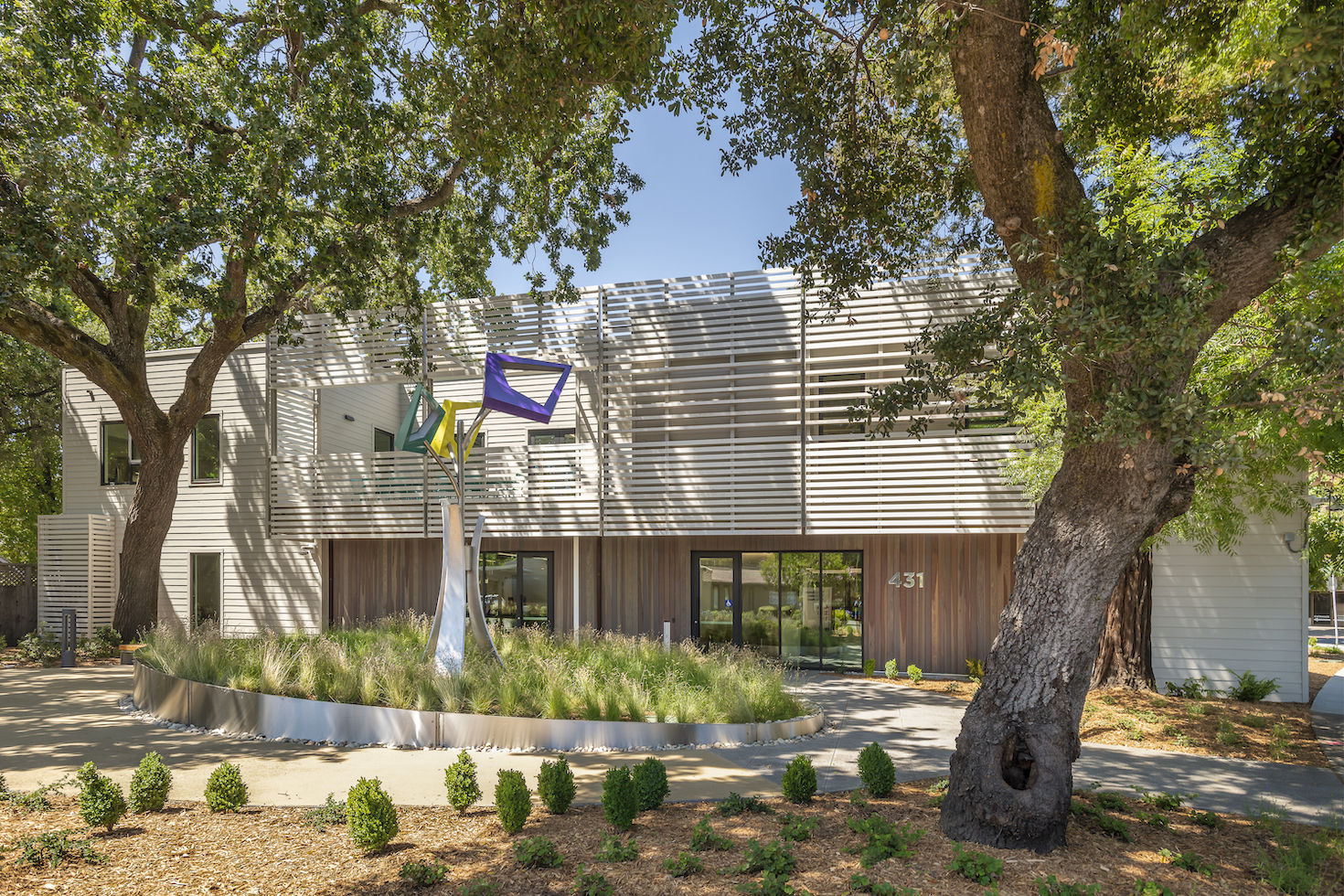Sonoma Clean Power, a community-owned electricity provider for California’s Sonoma and Mendocino counties, is the owner of a unique carbon neutral, 15,330-square-foot headquarters in Santa Rosa, California.
“As a public power provider, it is our responsibility to show our customers and community what the ultimate commitment to 100 percent renewable energy looks like in a world where no fossil fuels are needed,” said Geof Syphers, chief executive of Sonoma Clean Power.
Unlike net-zero energy buildings that focus on quantitative emissions reductions, the Sonoma Clean Power headquarters also leverages decarbonization through grid interaction — it takes into consideration when power is produced and used to engage with the electrical grid in an environmentally responsible manner. With buildings accounting for about 70 percent of electricity use, it is crucial that they play a role in grid decarbonization.
The high-performance building replaced an existing office building, which was one important step to achieving a zero carbon project. “Reusing the building is the biggest carbon win you can have to avoid embodied carbon emissions during this critical next decade,” said Brad Jacobson, principal at EHDD Architecture, the firm that designed the project. In fact, new construction is carbon intensive — concrete, steel and aluminum alone account for 23 percent of total global emissions.
The design team leveraged a “state of the shelf” approach, using simple best practices and readily available technology to achieve efficiency and effectiveness, according to Jacobson. For example, passive design strategies included opening up the existing structure for enhanced daylighting, upgrading to low-emissivity (thermally efficient) operable windows, fully insulating the building envelope, installing ceiling fans to maintain comfort and air sealing for energy efficiency.
To supplement its architectural design, the facility’s all-electric model has been engineered to establish a highly energy efficient building. “As a business, electrifying your workplace helps show your employees and customers what it physically looks like to operate a clean, energy-efficient building,” Syphers said.
The building’s gas line was removed due to new equipment specifications. The design team removed three natural gas-fired heating and cooling units and replaced them with four rooftop heat pump alternatives and one split heat pump system to account for the increased occupant density and change in spatial programming from the previous existing office building design. A commercial induction stove was also added to its new kitchen space.
Consequently, the project serves as a test case for electrifying existing buildings, the designers noted. “Many cities in California focused on electrification in new construction in the last code cycle and now jurisdictions and the California Air Resources Board are developing strategies for existing buildings in major remodels or end life equipment replacements,” said Ted Tiffany, director of sustainability at Guttmann & Blaevoet, the firm that served as the project’s lead building infrastructure and sustainability engineer.
Several other electrification measures in the headquarters have sealed its success as an energy saver. The headquarters has installed an impressive number of electric vehicle chargers — 23 in total — one for each and every parking stall available, incentivizing its staff to voluntarily purchase electric vehicles. The building also includes an installed 30-kilowatt solar photovoltaic system and 220-kWh battery system for renewable energy generation and back-up power, and it opts for 100 percent renewable electricity as offered by the local utility.
Perhaps the most innovative feature of all is the headquarter’s pioneering role as the first GridOptimal building. “In addition to placing renewables on the grid and pursuing electrification, we really need to manage when we place power on the grid,” Jacobson said.
The GridOptimal Buildings Initiative, a joint program between the New Buildings Institute and the U.S. Green Building Council, aligns building operation with low-carbon grid operation. Based on a real-time signal that dictates the carbon intensity of the grid at a given time, the microgrid of the Sonoma Clean Power headquarters draws electricity when there is a green grid with ample clean power. During high carbon times such as late summer afternoons when the sun goes down or early winter mornings, there is an opportunity to shift loads. “As the grid transforms and we move towards an electricity system with more varied renewables, it becomes increasingly critical that we match when clean power is available and when we are using power,” said Alexi Miller, acting director of building innovation at New Buildings Institute.
The headquarters can also store onsite solar generation or absorb clean energy from the grid in both its stationary battery system and vehicle charging stations when there is an abundance of clean power on the grid. Using a microgrid controller and WattTime software that can track grid emissions and identify times of peak demand or high carbon intensity the building can also place power back onto the grid to reduce its dependency on fossil fuel power plants. Therefore, the building’s microgrid also serves as a resilient backup in the event of a disaster.
In order to reduce emissions strain on the power grid, New Buildings Institute and the design team also partnered with Sonoma Clean Power to identify sustainable design strategies. Permanent building load modifications such as natural site shading reduce can solar heat gain and eliminate further cooling loads during what would be an energy-intensive period on the grid. Similarly, the all-electric and highly efficient HVAC system reduces the building’s electricity demand during peak cooling and heating periods. The building’s skylights, windows, daylight sensors and dimmable LED fixtures are programmed to minimize electric lighting when natural light is available.
Flexibility is built into key building systems, including HVAC controls and the battery controller — each of these systems has a manual override, empowering building operators to prioritize resiliency or other operational goals as needed. They can automatically adjust operations based on real-time grid carbon intensity, enabling the building to reduce its electricity demand during high-cost, high-carbon hours.
Sonoma Clean Power recognizes that its headquarters could serve as a model for how other regions, utilities, businesses and residents can advance building decarbonization and emissions reductions. “It’s crucial that businesses practice what they preach, especially if education is a part of the work they do. Everyone should do what they can to reduce their emissions and combat the climate crisis,” Syphers said.
The headquarters continues to attract the interest of outside entities as a living lab and teaching tool for grid-interaction and building electrification. “The more we engage with our customers and municipalities, the more opportunities there are to solve some of the biggest barriers to electrification, and reduce emissions even further. Our education efforts are the most effective way we can start to get past the fears and apprehensions, and connect people with the trusted information and solutions they are looking for,” Syphers said.

